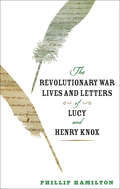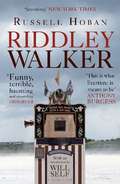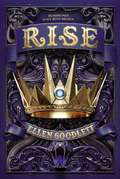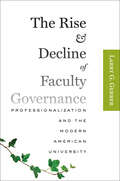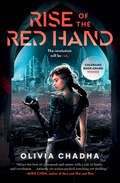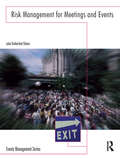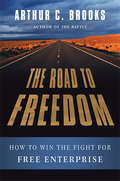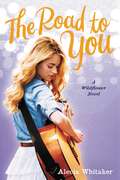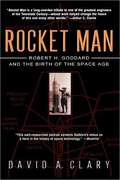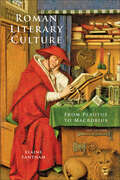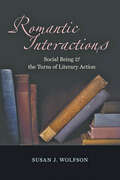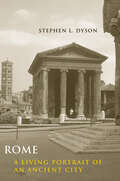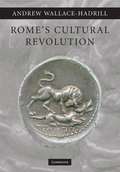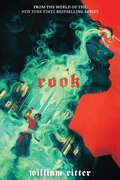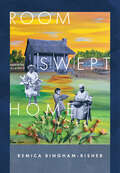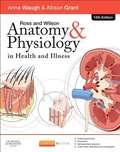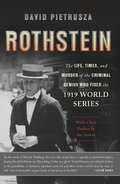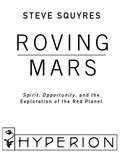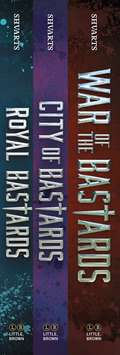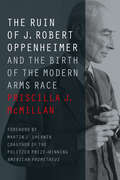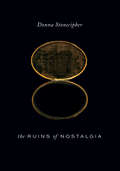- Table View
- List View
The Revolutionary War Lives and Letters of Lucy and Henry Knox
by Phillip HamiltonIn 1774, Boston bookseller Henry Knox married Lucy Waldo Flucker, the daughter of a prominent Tory family. Although Lucy;€™s father was the third-ranking colonial official in Massachusetts, the couple joined the American cause after the Battles of Lexington and Concord and fled British-occupied Boston. Knox became a soldier in the Continental Army, where he served until the war;€™s end as Washington;€™s artillery commander.While Henry is well known to historians, his private life and marriage to Lucy remain largely unexplored. Phillip Hamilton tells the fascinating story of the Knoxes;€™ relationship amid the upheavals of war. Like John and Abigail Adams, the Knoxes were often separated by the revolution and spent much of their time writing to one another. They penned nearly 200 letters during the conflict, more than half of which are reproduced and annotated for this volume.This correspondence;¢;‚¬;€?one of the few collections of letters between revolutionary-era spouses that spans the entire war;¢;‚¬;€?provides a remarkable window into the couple;€™s marriage. Placed at the center of great events, struggling to cope with a momentous conflict, and attempting to preserve their marriage and family, the Knoxes wrote to each other in a direct and accessible manner as they negotiated shifts in gender and power relations. Working together, Henry and Lucy maintained their household and protected their property, raised and educated their children, and emotionally adjusted to other dramatic changes within their family, including a total break between Lucy and her Tory family. Combining original epistles with Hamilton;€™s introductory essays, The Revolutionary War Lives and Letters of Lucy and Henry Knox offers important insights into how this relatable and highly individual couple overcame the war;€™s challenges.
The Revolutionary War Lives and Letters of Lucy and Henry Knox
by Phillip HamiltonIn 1774, Boston bookseller Henry Knox married Lucy Waldo Flucker, the daughter of a prominent Tory family. Although Lucy;€™s father was the third-ranking colonial official in Massachusetts, the couple joined the American cause after the Battles of Lexington and Concord and fled British-occupied Boston. Knox became a soldier in the Continental Army, where he served until the war;€™s end as Washington;€™s artillery commander.While Henry is well known to historians, his private life and marriage to Lucy remain largely unexplored. Phillip Hamilton tells the fascinating story of the Knoxes;€™ relationship amid the upheavals of war. Like John and Abigail Adams, the Knoxes were often separated by the revolution and spent much of their time writing to one another. They penned nearly 200 letters during the conflict, more than half of which are reproduced and annotated for this volume.This correspondence;¢;‚¬;€?one of the few collections of letters between revolutionary-era spouses that spans the entire war;¢;‚¬;€?provides a remarkable window into the couple;€™s marriage. Placed at the center of great events, struggling to cope with a momentous conflict, and attempting to preserve their marriage and family, the Knoxes wrote to each other in a direct and accessible manner as they negotiated shifts in gender and power relations. Working together, Henry and Lucy maintained their household and protected their property, raised and educated their children, and emotionally adjusted to other dramatic changes within their family, including a total break between Lucy and her Tory family. Combining original epistles with Hamilton;€™s introductory essays, The Revolutionary War Lives and Letters of Lucy and Henry Knox offers important insights into how this relatable and highly individual couple overcame the war;€™s challenges.
Riddley Walker (PDF)
by Russell Hoban'Walker is my name and I am the same. Riddley Walker. Walking my riddels where ever theyve took me and walking them now on this paper the same. There aint that many sir prizes in life if you take noatis of every thing. Every time will have its happenings out and every place the same. Thats why I finely come to writing all this down. Thinking on what the idear of us myt be. Thinking on that thing whats in us lorn and loan and oansome.' Composed in an English which has never been spoken and laced with a storytelling tradition that predates the written word, RIDDLEY WALKER is the world waiting for us at the bitter end of the nuclear road. It is desolate, dangerous and harrowing, and a modern masterpiece.
Rise (Rule #2)
by Ellen GoodlettDark pasts and forbidden romances haunt three ambitious sisters as they fight to inherit the throne in this sequel to Rule, which New York Times bestselling author Elly Blake called "dazzling" and "pulse-pounding."Sisters Akeylah, Ren, and Zofi are all a step closer to their dying father's throne, a step closer to the crown that will allow one of them to rule over Kolonya. But the sisters' pasts continue to haunt them. Each hides a secret marked with blood and betrayal, and now their blackmailer is holding nothing back. When King Andros discovers the sisters' traitorous pasts, the consequences will shake the entire kingdom to its core. As Kolonya's greatest threat stalks closer and closer, weaving a web of fear and deceit around Ren, Zofi, and Akeylah, even the people they love are under suspicion. If the sisters are going to survive, they'll have to learn to trust each other above all else and work together, not only to save themselves, but to protect everyone and everything they hold dear.With shocking reveals and suspenseful storytelling, this breathtaking sequel to Rule will keep you guessing until the very last page.
The Rise and Decline of Faculty Governance: Professionalization and the Modern American University
by Larry G. GerberThe Rise and Decline of Faculty Governance is the first history of shared governance in American higher education. Drawing on archival materials and extensive published sources, Larry G. Gerber shows how the professionalization of college teachers coincided with the rise of the modern university in the late nineteenth century and was the principal justification for granting teachers power in making educational decisions. In the twentieth century, the efforts of these governing faculties were directly responsible for molding American higher education into the finest academic system in the world. In recent decades, however, the growing complexity of "multiversities" and the application of business strategies to manage these institutions threatened the concept of faculty governance. Faculty shifted from being autonomous professionals to being "employees." The casualization of the academic labor market, Gerber argues, threatens to erode the quality of universities. As more faculty become contingent employees, rather than tenured career professionals enjoying both job security and intellectual autonomy, universities become factories in the knowledge economy. In addition to tracing the evolution of faculty decision making, this historical narrative provides readers with an important perspective on contemporary debates about the best way to manage America’s colleges and universities. Gerber also reflects on whether American colleges and universities will be able to retain their position of global preeminence in an increasingly market-driven environment, given that the system of governance that helped make their success possible has been fundamentally altered.
The Rise and Decline of Faculty Governance: Professionalization and the Modern American University
by Larry G. GerberThe Rise and Decline of Faculty Governance is the first history of shared governance in American higher education. Drawing on archival materials and extensive published sources, Larry G. Gerber shows how the professionalization of college teachers coincided with the rise of the modern university in the late nineteenth century and was the principal justification for granting teachers power in making educational decisions. In the twentieth century, the efforts of these governing faculties were directly responsible for molding American higher education into the finest academic system in the world. In recent decades, however, the growing complexity of "multiversities" and the application of business strategies to manage these institutions threatened the concept of faculty governance. Faculty shifted from being autonomous professionals to being "employees." The casualization of the academic labor market, Gerber argues, threatens to erode the quality of universities. As more faculty become contingent employees, rather than tenured career professionals enjoying both job security and intellectual autonomy, universities become factories in the knowledge economy. In addition to tracing the evolution of faculty decision making, this historical narrative provides readers with an important perspective on contemporary debates about the best way to manage America’s colleges and universities. Gerber also reflects on whether American colleges and universities will be able to retain their position of global preeminence in an increasingly market-driven environment, given that the system of governance that helped make their success possible has been fundamentally altered.
Rise of the Red Hand (The\mechanists Ser. #1)
by Olivia ChadhaA rare, searing portrayal of the future of climate change in South Asia. A streetrat turned revolutionary and the disillusioned hacker son of a politician try to take down a ruthlessly technocratic government that sacrifices its poorest citizens to build its utopia.
Risk Management for Enterprises and Individuals
by Etti Baranoff Patrick Lee Brockett Yehuda KahaneThis book is intended for the Risk Management and Insurance course where Risk Management is emphasized. When we think of large risks, we often think in terms of natural hazards such as hurricanes, earthquakes or tornados. Perhaps man-made disasters come to mind such as the terrorist attacks in the U.S. on September 11, 2001. Typically we have overlooked financial crises, such as the credit crisis of 2008. However, these types of man-made disasters have the potential to devastate the global marketplace. Losses in multiple trillions of dollars and in much human suffering and insecurity are already being totaled, and the global financial markets are collapsing as never before seen. We can attribute the 2008 collapse to financially risky behavior of a magnitude never before experienced. The 2008 U.S. credit markets were a financial house of cards. A basic lack of risk management (and regulators' inattention or inability to control these overt failures) lay at the heart of the global credit crisis. This crisis started with lack of improperly underwritten mortgages and excessive debt. Companies depend on loans and lines of credit to conduct their routine business. If such credit lines dry up, production slows down and brings the global economy to the brink of deep recession or even depression. The snowballing effect of this failure to manage the risk associated with providing mortgage loans to unqualified home buyers have been profound, indeed. When the mortgages failed because of greater risk- taking on the Street, the entire house of cards collapsed. Probably no other risk-related event has had, and will continue to have, as profound an impact world wide as this risk management failure. How was risk in this situation so badly managed? What could firms and individuals have done to protect themselves? How can government measure such risks (beforehand) to regulate and control them? These and other questions come to mind when we contemplate the consequences of this risk management fiasco. Standard risk management practice would have identified sub-prime mortgages and their bundling into mortgage-backed-securities as high risk. People would have avoided these investments or would have put enough money into reserve to be able to withstand defaults. This did not happen. Accordingly, this book may represent one of the most critical topics of study that the student of the 21st century could ever undertake. Risk management will be a major focal point of business and societal decision making in the 21st century. A separate focused field of study, it draws on core knowledge bases from law, engineering, finance, economics, medicine, psychology, accounting, mathematics, statistics and other fields to create a holistic decision-making framework that is sustainable and value- enhancing. This is the subject of this book.
Risk Management for Meetings and Events (1st Edition)
by Julia Rutherford SilversEvents of all types are produced every day for all manner of purposes, attracting all sorts of people. Creating and managing the environment in which these people will gather carries with it awesome responsibilities - legal, ethical, and financial. To provide a safe and secure setting and to operate in a manner that ensures the hosting organizations or individuals achieve their objectives in a proper and profitable way, event risk management must be fully integrated into all event plans and throughout the event management process.Risk Management for Meetings and Events examines the practices, procedures, and safeguards associated with the identification, analysis, response planning, and control of the risks surrounding events of all types. Written by an experienced author it:* Provides a solid, easy-to-read conceptual foundation based on proven risk management techniques* Includes ready-to-use templates designed specifically as learning exercises for students and professionals* Comprehensively discusses effective strategies for managing the risks associated with design, planning and production of public and private events Risk Management for Meetings and Events is a comprehensive and practical guide which supports academic and professional development programs that prepare individuals for entering or advancement in the meeting and event management industry.
Risk Management for Meetings and Events (1st Edition) (PDF)
by Julia Rutherford SilversEvents of all types are produced every day for all manner of purposes, attracting all sorts of people. Creating and managing the environment in which these people will gather carries with it awesome responsibilities - legal, ethical, and financial. To provide a safe and secure setting and to operate in a manner that ensures the hosting organizations or individuals achieve their objectives in a proper and profitable way, event risk management must be fully integrated into all event plans and throughout the event management process.Risk Management for Meetings and Events examines the practices, procedures, and safeguards associated with the identification, analysis, response planning, and control of the risks surrounding events of all types. Written by an experienced author it:* Provides a solid, easy-to-read conceptual foundation based on proven risk management techniques* Includes ready-to-use templates designed specifically as learning exercises for students and professionals* Comprehensively discusses effective strategies for managing the risks associated with design, planning and production of public and private events Risk Management for Meetings and Events is a comprehensive and practical guide which supports academic and professional development programs that prepare individuals for entering or advancement in the meeting and event management industry.
The Road to Freedom: How to Win the Fight for Free Enterprise
by Arthur C. BrooksEntrepreneurship, personal responsibility, and upward mobility: These traditions are at the heart of the free enterprise system, and have long been central to America&’s exceptional culture. In recent years, however, policymakers have dramatically weakened these traditions—by exploding the size of government, propping up their corporate cronies, and trying to reorient our system from rewarding merit to redistributing wealth. In The Road to Freedom, American Enterprise Institute President Arthur C. Brooks shows that this trend cannot be reversed through materialistic appeals about the economic efficiency of capitalism. Rather, free enterprise requires a moral defense rooted in the ideals of earned success, equality of opportunity, charity, and basic fairness. Brooks builds this defense and demonstrates how it is central to understanding the major policy issues facing America today.The future of the free enterprise system has become a central issue in our national debate, and Brooks offers a practical manual for defending it over the coming years. Both a moral manifesto and a prescription for concrete policy changes, The Road to Freedom will help Americans in all walks of life translate the philosophy of free enterprise into action, to restore both our nation&’s greatness and our own well-being in the process.
The Road to You (Wildflower #2)
by Alecia WhitakerBright lights...screaming fans...cute roadies...country music sensation Bird Barrett has officially arrived.Next up on the road to stardom, Bird's heading out on tour. Between opening for one of the biggest acts in country music and meeting a passionate young photographer who's working as part of the backstage crew, the weeks pass by in an exciting blur. It might even be enough to distract Bird from the way things ended--or never quite started--with Adam Dean.When the tour wraps, though, it's back to reality. The label is eager for a new hit song, but the sudden fame, complete with a media-fueled rivalry with another country music starlet, has Bird questioning her priorities. Before she can pour her heart into her music, she'll need to figure out where it truly lies. Filled with sweet country music spirit, Wildflower is a series you just can't get out of your head.
Rocket Man: Robert H. Goddard and the Birth of the Space Age
by David A. ClaryMore famous in his day than Einstein or Edison, the troubled, solitary genius Robert H. Goddard (1882-1945) was the American father of rocketry and space flight, launching the world's first liquid-fuel rockets and the first powered vehicles to break the sound barrier. Supported by Charles Lindbergh and Harry Guggenheim, through fiery, often explosive, experiments at Roswell, New Mexico, he invented the methods that carried men to the moon. Today, no rocket or jet plane can fly without using his inventions. Yet he is the "forgotten man" of the space age. His own government ignored his rocketry until the Germans demonstrated its principles in the V-2 missiles of World War II. The American government usurped his 214 patents, while suppressing his contributions in the name of national security, until it was forced to pay one million dollars for patent infringement. Goddard became famous again, monuments and medals raining upon his memory. But his renewed fame soon faded, and Goddard's pivotal role in launching the Space Age has been largely forgotten.
Roman Literary Culture: From Plautus to Macrobius (Ancient Society and History)
by Elaine FanthamScholars of ancient literature have often focused on the works and lives of major authors rather than on such questions as how these works were produced and who read them. In Roman Literary Culture, Elaine Fantham fills that void by examining the changing social and historical context of literary production in ancient Rome and its empire. Fantham’s first edition discussed the habits of Roman readers and developments in their means of access to literature, from booksellers and copyists to pirated publications and libraries. She examines the issues of patronage and the utility of literature and shows how the constraints of the physical object itself—the ancient "book"—influenced the practice of both reading and writing. She also explores the ways in which ancient criticism and critical attitudes reflected cultural assumptions of the time.In this second edition, Fantham expands the scope of her study. In the new first chapter, she examines the beginning of Roman literature—more than a century before the critical studies of Cicero and Varro. She discusses broader entertainment culture, which consisted of live performances of comedy and tragedy as well as oral presentations of the epic. A new final chapter looks at Pagan and Christian literature from the third to fifth centuries, showing how this period in Roman literature reflected its foundations in the literary culture of the late republic and Augustan age. This edition also includes a new preface and an updated bibliography.
Romantic Interactions: Social Being and the Turns of Literary Action
by Susan J. WolfsonIn Romantic Interactions, Susan J. Wolfson examines how interaction with other authors—whether on the bookshelf, in the embodied company of someone else writing, or in relation to literary celebrity—shaped the work of some of the best-known (and less well-known) writers in the English language. Working across the arc of Long Romanticism, from the 1780s to the 1840s, this lively study involves writing by women and men, in poetry and prose. Combining careful readings with sophisticated literary, historical, and cultural criticism, Wolfson reveals how various writers came to define themselves as "author." The story unfolds not only in deft textual analyses but also by provocatively placing writers in dialogue with what they were reading, with one another, and with the community of readers (and writers) their writings helped bring into being: Mary Wollstonecraft and Charlotte Smith in the Revolution-roiled 1790s; William Wordsworth and Dorothy Wordsworth in the society of the Lake District; Lord Byron, a magnet for writers everywhere, inspired, troubled, but always arrested by what he (and his scandal-ridden celebrity) represented. This fresh, informative account of key writers, important texts, and complex cultural currents promises keen interest for students and scholars, literary critics, and cultural historians.
Rome: A Living Portrait of an Ancient City (Ancient Society and History)
by Stephen L. DysonStephen L. Dyson has spent a lifetime studying and teaching the history of ancient Rome. That unparalleled knowledge is reflected in his magisterial overview of the Eternal City.Rather than look only at the physical development of the city—its buildings, monuments, and urban spaces—Dyson also explores its social, economic, and cultural histories. This unique approach situates Rome against a background of comparative urban history and theory, allowing Dyson to examine the dynamic society that once thrived there. In his personal effort to reconstruct the city, Dyson populates its streets with the hurried politicians, hawking vendors, and animated students that once lived, worked, and studied there, bringing the ancient city to life for a new generation of students and tourists. Dyson follows Rome as it developed between the third century BC and the fourth century AD, dividing the great megalopolis into distinct neighborhoods and locales. He shows how these communities, each with its own unique customs and colorful inhabitants, eventually grew into the great imperial capital of the Italian Empire. Dyson integrates the full range of sources available—literary, artistic, epigraphic, and archaeological—to create a comprehensive history of the monumental city. In doing so, he offers a dramatic picture of a complex and changing urban center that, despite its flaws, flourished for centuries.
Rome's Cultural Revolution (PDF)
by Andrew Wallace-HadrillDrawing equally on archaeological and literary evidence, this book offers an original interpretation of the fundamental transformations of Rome's society, culture and identity during the period of its imperial expansion.
Rook
by William RitterThis standalone adventure set in the world of the New York Times bestselling Jackaby series brims with humor, heart, and—of course—a hefty dose of supernatural mayhem. Abigail Rook never intended to be the mortal bridge between the human and supernatural world. But now, the power of the Sight--and all the chaos that comes with seeing the essential truth of everything, every human, fairy, werewolf, enchanted slip of paper, and municipal building, at all times--is hers alone. With this overwhelming new gift, she should be able to solve crimes and help New Fiddleham, New England find calm in its supernatural chaos. The only problem? She has no idea what she&’s doing. And New Fiddleham isn't waiting for Abigail to be ready. Local witches and other magical beings are going missing, as tensions between human and supernatural residents curdle into a hatred that could tear the city apart. Abigail's fiance, Charlie, works alongside her to unravel the magical disappearances, but as a shapeshifter, he's under threat as well. Then Abigail's parents appear, ready to take her back to England and marry her off to someone she's never met. Abigail has no choice but to follow her Sight, her instincts, and any clues she can find to track a culprit who is trying destroy everything she holds dear.
Room Swept Home (Wesleyan Poetry Series)
by Remica Bingham-RisherRoom Swept Home serves as a gloriously rendered magnifying glass into all that is held in the line between the private and public, the investigative and generative, the self and those who came before us. In a strange twist of kismet, two of Bingham-Risher's ancestors intersect in Petersburg, Virginia, forty years before she herself is born: her paternal great-great-great grandmother, Minnie Lee Fowlkes, is interviewed for the Works Progress Administration Slave Narratives in Petersburg in 1937, and her maternal grandmother, Mary Knight, is sent to Petersburg in 1941, diagnosed with "water on the brain"—postpartum depression being an ongoing mystery—nine days after birthing her first child. Marrying meticulous archival research with Womanist scholarship and her hallmark lyrical precision, Bingham-Risher's latest collection treads the murky waters of race, lineage, faith, mental health, women's rights, and the violent reckoning that inhabits the discrepancy between lived versus textbook history, asking: What do we inherit when trauma is at the core of our fractured living? [sample poem] XI. the more ground covered, the more liberated you became I am scared my mind will turn on me. I am scared I will be naked in a burning house. I am scared my children won't outpace me.I am scared my children (who aren't made by me) believe I am a sad imitation of the others.I am scared I will gather in a roomwhere everyone will ask me to rememberand when I don't lie they'll say I'd hate to be you. I've lived long enough to be scared my kidneys will give out on me. I've lived long enough to know just when they should. I have never shared my fears with anyone; I am scared they will map the land and take liberties. Will the women be ashamed? I'm scared to ask. What will live again? What will die with me?
Ross and Wilson Anatomy and Physiology In Health and Illness (12th edition) (PDF)
by Anne Waugh Allison Grant12th edition. Ross and Wilson has been the number one choice for over a million students since it first published, over 50 years ago. One of the world's most popular textbooks of anatomy and physiology, it introduces the structure and functions of the human body and the effects of disease or illness on normal body function. More than any other text Ross and Wilson uses easy-to-understand, straightforward language, enhanced by colour illustrations and a huge range of interactive online activities, to make learning more visual and engaging. Ross and Wilson is essential reading for anyone embarking on a career as a healthcare professional, especially in the nursing and allied health professions, complementary / alternative medicine or as paramedics and ambulance technicians. "There are new sections on the implications of normal ageing on the structure and function of the body systems. The glossary has been expanded, as have the online access, learning outcomes and normal values tables. This book is excellent value for money. " Reviewed by: Nursing Standard Date: Aug 2014 Carefully refined, clear and unambiguous text which omits the unnecessary detail that can confuse the student new to the subject Highly illustrated with clear colour diagrams and photographs Regular sequences of headings, lists and bullet points help with learning and revision Learning outcomes related to the sections within each chapter Common prefixes, suffixes and roots commonly used in anatomy and physiology Appendix containing useful biological values for easy reference Access to additional electronic resources, including high-quality animations, colouring exercises, case studies, self-testing questions, an audio pronunciation guide and weblinks An accompanying Colouring and workbook that facilitates structured learning and revision of the material in this book. Fully revised and updated text, with a focus on the most commonly occurring disorders New sections on the implications of normal ageing on the structure and function of the body systems to reinforce the core material and reflect today's ageing population A new, easy-to-use colouring feature has been added to the extensive and varied selection of highly popular web-based online revision activities Additional coloured electron micrographs and photographs, as well as updated illustrations Extended glossary for fast, convenient and concise reference to important terminology. Alternate ISBNs 9780702053214 9780702053269
Rothstein: The Life, Times, and Murder of the Criminal Genius Who Fixed the 1919 World Series
by David PietruszaHistory remembers Arnold Rothstein as the man who fixed the 1919 World Series, an underworld genius. The real-life model for The Great Gatsby's Meyer Wolfsheim and Nathan Detroit from Guys and Dolls, Rothstein was much more-and less-than a fixer of baseball games. He was everything that made 1920s Manhattan roar. Featuring Jazz Age Broadway with its thugs, speakeasies, showgirls, political movers and shakers, and stars of the Golden Age of Sports, this is a biography of the man who dominated an age. Arnold Rothstein was a loan shark, pool shark, bookmaker, thief, fence of stolen property, political fixer, Wall Street swindler, labor racketeer, rumrunner, and mastermind of the modern drug trade. Among his monikers were "The Big Bankroll," "The Brain," and "The Man Uptown." This vivid account of Rothstein's life is also the story of con artists, crooked cops, politicians, gang lords, newsmen, speakeasy owners, gamblers and the like. Finally unraveling the mystery of Rothstein's November 1928 murder in a Times Square hotel room, David Pietrusza has cemented The Big Bankroll's place among the most influential and fascinating legendary American criminals. 16 pages of black-and-white photographs are featured.
Roving Mars: Spirit, Opportunity, and the Exploration of the Red Planet
by Steven SquyresSteve Squyres is the face and voice of NASA's Mars Exploration Rover mission. Squyres dreamed up the mission in 1987, saw it through from conception in 1995 to a successful landing in 2004, and serves as the principal scientist of its $400 million payload. He has gained a rare inside look at what it took for rovers Spirit and Opportunity to land on the red planet in January 2004--and knows firsthand their findings.
Royal Bastards Series Collection (Royal Bastards)
by Andrew ShvartsJoin an epic, action-packed magical adventure, full of conspiracies and danger, in the Royal Bastards fantasy series.Royal Bastards: Being a bastard blows. Tilla would know. Her father, Lord Kent of the Western Province, loved her as a child, but cast her aside as soon as he had trueborn children. At sixteen, Tilla spends her days exploring long-forgotten tunnels beneath the castle with her stablehand half-brother, Jax, and her nights drinking with the servants, passing out on Jax's floor while her castle bedroom collects dust. Tilla longs to sit by her father's side, enjoying feasts with the rest of the family. Instead, she sits with the other bastards, like Miles of House Hampstedt, an awkward scholar who's been in love with Tilla since they were children. The bastards band together, realizing they alone have the power to prevent a civil war that will tear their kingdom apart—if they can warn the king in time....City of Bastards: Tilla is safe from her murderous father in the dazzling capital of Lightspire, where she lives a life of luxury under the protection of the Volaris King, alongside her boyfriend, Zell, and best friend, Princess Lyriana. So why isn't she happy? Maybe it's the whispers and stares that follow her wherever she goes, as the daughter of the traitor waging war against Lightspire. Or maybe it's the memories of her beloved brother, Jax, who lies cold in his grave even as she tries to settle into a life in the city's prestigious University. Then Tilla stumbles upon the body of a classmate—a friend. The authorities are quick to rule it a suicide and sweep it under the rug, but when Tilla herself is attacked by a mysterious man with terrifying powers, she's convinced of a conspiracy. Her friends beg her to stay silent; what she's suggesting is impossible...and treasonous. The deeper she digs, the more questions she uncovers....War of the Bastards: A year has passed since the fall of Lightspire. The Inquisitor Miles Hampstedt rules Noveris with a blood-soaked iron fist. Tilla and her friends have become hardened rebels in the Unbroken, a band of guerilla fighters hiding out on the fringes of the Kingdom protecting the true queen, Lyriana Volaris. Even as they fight, they know their cause is doomed—that with every passing day Miles's army of Bloodmages spreads across the continent. But at least they have each other...and some halfway-decent drinks. With Miles's forces closing in, a ragtag team sets out on an eleventh-hour mission: form an alliance with Syan's people that could turn the tide of the war. But what they discover in the Red Wastes changes everything, including their very understanding of the magic that runs through Noveris. In the heart-pounding conclusion to the Royal Bastards trilogy, Tilla faces an impossible choice: unthinkable destruction in the name of peace...or an uncertain future that means confronting a terrible past.
The Ruin of J. Robert Oppenheimer: And the Birth of the Modern Arms Race (Johns Hopkins Nuclear History and Contemporary Affairs)
by Priscilla J. McMillanOn April 12, 1954, the nation was astonished to learn that J. Robert Oppenheimer was facing charges of violating national security. Could the director of the Manhattan Project, the visionary who led the effort to build the atom bomb, really be a traitor? In this riveting book, bestselling author Priscilla J. McMillan draws on newly declassified U.S. government documents and materials from Russia, as well as in-depth interviews, to expose for the first time the conspiracy that destroyed one of America;€™s most illustrious scientists.McMillan recreates the fraught years from 1949 to 1955 when Oppenheimer and a group of liberal scientists tried to head off the cabal of hard-line air force officials, anti-Communist politicians, and rival scientists, including physicist Edward Teller, who were trying to seize control of U.S. policy and build ever more deadly nuclear weapons. Retelling the story of Oppenheimer;€™s trial, which took place in utmost secrecy, she describes how the government made up its own rules and violated many protections of the rule of law. She also argues that the effort to discredit Oppenheimer, occurring at the height of the McCarthy era and sanctioned by a misinformed President Eisenhower, was a watershed in the Cold War, poisoning American politics for decades and creating dangers that haunt us today.A chilling tale of McCarthy-era machinations, this groundbreaking page-turner rewrites the history of the Cold War.
The Ruins of Nostalgia (Wesleyan Poetry Series)
by Donna StonecipherWhat is it to feel nostalgia, to be skeptical of it yet cleave intently to the complex truths of feeling and thought? In a series of 64 gorgeous, ramifying, unsettling prose poems addressing late-twentieth- and twenty-first century experience and its discontents, The Ruins of Nostalgia offers a strikingly original exploration of the misunderstood phenomenon of nostalgia as both feeling-state and historical phenomenon. Each poem, also titled The Ruins of Nostalgia, is a kind of lyrical mini-essay, playful, passionate, analytic. Some poems take a location, memory, conceit, or object as their theme. Throughout the series, the poems recognize and celebrate the nostalgias they ironize, which are in turn celebrated and then ironized again. Written often in the fictional persona of the first-person plural, The Ruins of Nostalgia explores the rich territory where individual response meets a collective phenomenon.[sample poem]The Ruins of Nostalgia 13Where once there had been a low-end stationery store minded by an elderly beauty queen, there was now a store for high-end espresso machines minded by nobody. Where once there had been an illegal beer garden in a weedy lot, there was now a complex of luxury lofts with Parisian-style ivory façades. Where once there had been a bookstore and a bike shop and a bakery, there was now a wax museum for tourists. Where once there had been an empty lot there was now a building. Where once there had been an empty lot there was now a building. Where once there had been an empty lot there was now a building. Where once there had been an empty lot there was now a building. Where once there had been farms there were now subdivisions. Where once there had been subdivisions there were now sub-subdivisions. We lived in a sub-subdivision of a subdivision. We ourselves had become subdivided—where once we had merely been of two minds. * Where once there had been a river there was now a road. A vocal local group had started a movement to break up the road and "daylight" the river, which still flowed, in the dark, underneath the road. * Could we daylight the farms, the empty lots, the stationery store, the elderly beauty queen, the city we moved to? Was it still flowing somewhere, under the luxury lofts, deliquescing in the dark, inhabited by our luxury selves, not yet subdivided, because not yet whole? * Could we daylight the ruins of nostalgia?
